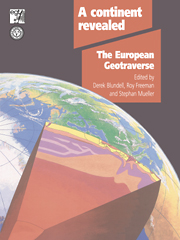6 - TECTONIC EVOLUTION OF EUROPE
Published online by Cambridge University Press: 05 November 2009
Summary
In this chapter we discuss the geology and the crustal and lithospheric tectonics as viewed against the background of the information presented in Chapters 3, 4, and 5. Again we proceed from north to south along the EGT, working from the oldest to the youngest units. General reference should be made to the tectonic, gravity and magnetic maps (1, 9 and 10) of the EGT Atlas.
PRECAMBRIAN EUROPE
B. Windley
Precambrian rocks are unevenly distributed throughout Europe. The Lewisian Complex in NW Scotland was accreted from Laurentia during formation of the Caledonian orogen and is far removed from the European Geotraverse. The main area of Precambrian rocks is in the Baltic Shield. South of this there are few Precambrian outcrops, but a few Precambrian ages are known from isotopic work on zircons. Precambrian rocks of Gondwana crop out in northern Africa, but at the southern end of EGT in Tunisia they are only known in wells. This section therefore concentrates on the Baltic Shield.
THE BALTIC SHIELD
There is an overall decrease in age from NE to SW of rocks and structures within the Baltic Shield, the main tectonic units of which are shown in Figure 6–1 (EUGENO-S Working Group 1988). In the north the Kola–Karelian orogen contains five Archaean terranes, which were amalgamated by collision tectonics in the period 2.0–1.9 Ga. In contrast, in the south the Sveco-Fennian orogen contains no Archaean material, consisting of new crust (<2.2 Ga) that was accreted and underwent collisions in the period 2.0–1.8 Ga and was reworked by crustal melting in the period 1.8–1.54 Ga.
- Type
- Chapter
- Information
- A Continent RevealedThe European Geotraverse, Structure and Dynamic Evolution, pp. 139 - 214Publisher: Cambridge University PressPrint publication year: 1992
- 9
- Cited by

